
Marathi Cinema, also known as Marathi film industry, is the segment of Indian cinema, dedicated to the production of motion pictures in the Marathi language widely spoken in the state of Maharashtra. It is based in Mumbai. It is the oldest film industry of India and one of the leaders in filmmaking in the Indian film industry.
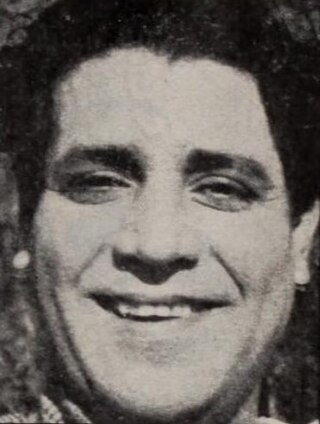
Agha was an Indian actor of Bollywood films. He was known for comic roles and modeled himself on Bob Hope's style of acting. He appeared in over 300 Hindi films in his career between 1935 and 1986. His son, Jalal Agha, also became an actor, mostly known for the song Mehbooba Mehbooba in Sholay (1975).
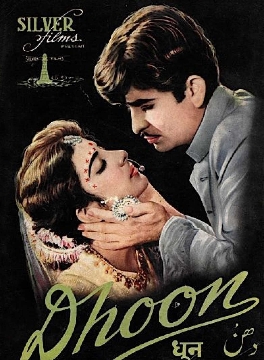
Dhoon is a 1953 Bollywood film directed by M. Kumar. The film was produced by Silver Kings, a production company formed by Kumar and his then wife, actress Pramila. The film stars Raj Kapoor, Nargis, Motilal, Kumar, Pramila, E. Bilmoria, Leela Mishra and Kamal Mehra. Mehra was a lesser known comedian who started his career in 1951 with Naujawan. He went on to act in several films before starting his own production company Pride Of India under which he made films like Kismat (1968), Mahal (1969) and Naami Chor (1977). The music was composed by Madan Mohan.

Bansari is a Bollywood social film. It was released in 1943. Music composition was by Gyan Dutt with lyrics written by D. N. Madhok. The film was produced by Chandulal Shah for Ranjit Studios. Directed by Jayant Desai, it starred Ishwarlal, Noor Mohammed Charlie, Dixit, Shamim Bano, Kesari and Urmila.
Raja Nawathe; 14 October 1924 – 15 November 2005) was an Indian film producer, director, assistant film director, in Bombay's Hindi film industry, long before it came to be known as Bollywood. He is known for films like Raj Kapoor-Nargis starrer Aah (1953) and thriller Gumnaam (1965).
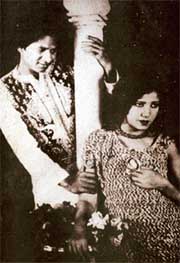
Master Vithal or Vithal (1906-1969) was an actor in Indian cinema, best known as the hero of India's first talkie Alam Ara (1931) and of Marathi and Hindi silent stunt films, which gave him the epithet as the Douglas Fairbanks of India.
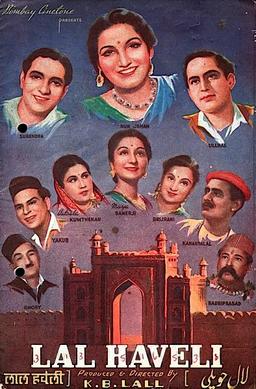
Lal Haveli is a Bollywood film. It was released on 15 December 1944. The film was directed by K. B. Lall, for whom it was a debut directorial venture. Lall had started his career playing a villain in Sohrab Modi's Bharosa (1940), and as a "storywriter" with the V. C. Desai directed film Radhika (1941), finally producing Savera (1942) directed by V. C. Desai, before turning his hand at direction with Lal Haveli.
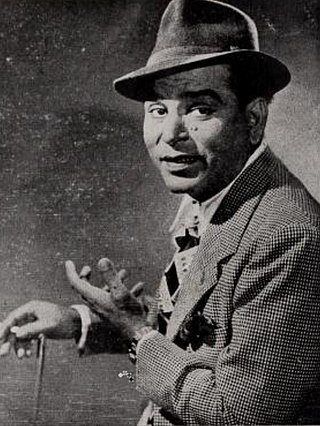
Yakub Khan, known as Yakub, was an Indian actor born into a Pathan family in Jabalpur, Madhya Pradesh, India. He is best known for his comic and comic villainous roles.
Jayant Desai was an Indian film director and producer. After graduating from the University of Bombay Desai joined Ranjit Studios in 1929 where he directed numerous films including Toofani Toli (1937), Tansen (1943), Har Har Mahadev (1950) and Amber (1952). Tansen was the second highest grossing Indian film of 1943. Besides film direction he also acted in several films. In 1943 he left Ranjit Studios to found his own production company, Jayant Desai Productions. In 1960s he founded Jupiter Films and Hemlata Pictures.

Noor Mohammed Charlie, popularly known as Charlie, was an Indian/ Pakistani actor born in 1911 in Ranavav village, Porbandar, Saurashtra, India. Best known for his comedy roles, he was the first 'star' comedian and has been referred to as India's first comedy king. He acted with several top actresses of those days as a comic hero. Being a great fan of Charlie Chaplin, he took the name "Charlie" as his screen name following the release of his popular film The Indian Charlie (1933). He had a successful career in pre-partition India from 1925–1946. His shift to Pakistan following partition saw his career going down with less than 12 films. He shifted to the US to live with his son and returned later to Pakistan where he died in 1983.
Sarvottam Badami (1910–2005) was an Indian film director of Hindi, Telugu, and Tamil films. He started his career as a sound recordist for the first talkie in India, Alam Ara (1931). In 1948 he helped set up the Films Division for news-reel and documentaries, where he worked as the chief producer in the newsreel department and also made documentaries. His active years were from 1932 to 1952 when he retired from the Films Division and from making feature films to settle in Bangalore.
Sajani is a 1940 Hindi social film directed by Sarvottam Badami for Sudama Productions. Scripted by Zia Sarhadi, the film had music by Gyan Dutt and starred Prithviraj Kapoor, Sabita Devi, Snehprabha Pradhan, Noor Jehan, Dixit, and Ghory. Badami left Sagar Movietone where he had made satirical comedies to join his "mentor" Ambalal Patel at Sudama Productions to make "socially relevant film(s)", where Sajani was one of the first. Snehprabha Pradhan acted in several films produced by Chimanbhai Desai in 1940, including Sajani.

Mehtab (1913–1997) was an Indian actress of Hindi/Urdu films who worked from 1928 to 1969. She was born in Sachin, Gujarat, to a Muslim family and named Najma. Her father, Nawab Sidi Ibrahim Mohammad Yakut Khan III, was the Nawab of Sachin, near Surat in the state of Gujarat. Starting her career in the late 1920s with small roles in films like Second Wife (1928), Indira B. A. (1929) and Jayant (1929), she went on to do character roles before acting in the lead opposite Ashraf Khan in Veer Kunal (1932). After almost a decade of doing mainly action-oriented roles, she came into prominence with the Kidar Sharma-directed Chitralekha (1941).
![<i>Thokar</i> 1939 [[British India]] film](https://upload.wikimedia.org/wikipedia/en/thumb/d/db/Thokar_1939.jpg/320px-Thokar_1939.jpg)
Thokar also called The Kick is 1939 Hindi/Urdu film directed by A. R. Kardar. Produced by Chandulal Shah for his production banner Ranjit Movietone, it had music by Gyan Dutt. The story writer was M. Sadiq, with cinematography by Gordhanbhi Patel. The cast included Kumar, Ishwarlal, Madhuri, Yakub, Noor Mohammed Charlie, Ram Marathe, Waheedan Bai and Dixit.
![<i>Bhabhi</i> (1938 film) 1938 [[British India]] film](https://upload.wikimedia.org/wikipedia/commons/thumb/5/5f/Bhabhi_1938.jpg/320px-Bhabhi_1938.jpg)
Bhabhi (Sister-in-Law) is a 1938 social family drama Hindi film directed by Franz Osten. The film was based on a Bengali novel written by Sharadindu Bandyopadhyay called "Bisher Dhoan". Bandyopadhyay was a famous Bengali novelist and short story writer also known as the creator of the fictional detective Byomkesh Bakshi. The cinematographers were Wirsching and Pareenja. Dialogues and lyrics by J. S. Casshyap. V. H. Desai, the comedian, got his "big break" in Bhabhi when he joined Bombay Talkies. He became popular as the nervous father of the heroine Renuka Devi. S. N. Tripathi started his acting with a small role in the film. The film had the new found Renuka Devi in the lead.

Karan Dewan was an Indian cinema actor in Hindi films. He worked in over seventy films from 1941 to 1979. He started as a journalist while still in college, editing a film-based magazine in Urdu. His brother was the film producer and director Jaimani Dewan.

Chaturbhuj Doshi (1894–1969) was a Hindi and Gujarati writer-director of Indian cinema. He was one of the top Gujarati screenplay writers, who helped script stories for the Punatar productions. He is stated to be one of the leading figures who launched the Gujarati film industry with work on notable films like Gunsundari (1948) and Nanand Bhojai (1948). Doshi, was “well known” for his family socials and had become “a celebrity in his own right”. He made a name for himself as a journalist initially and was referred to as the "famous journalist" and publicist by Baburao Patel, editor of Filmindia.

Sagar Movietone also Sagar Films, Sagar Film Company and Sagar Productions was an Indian film production company involved in the making of films for Indian cinema. It was launched by Ardeshir Irani with Chimanlal Desai and Dr. Ambalal Patel in 1929 in Bombay, Maharashtra, India. Sagar was initially started as a branch company of Ardeshir's Imperial Film Company. Several key figures from Imperial, such as Mehboob Khan were shifted to Sagar. The studio was in operation from 1930 to 1939. In 1940, it combined with General Pictures to form National Studios. It made "Parsi theatre based films, mythologicals and stunt movies". Sagar fostered the career of many artists who rose to prominence. Early directors such as Prafulla Ghosh, Sarvottam Badami, Ezra Mir and Nanubhai Vakil were promoted by the company. Mehboob Khan got his first break as a director in Al Hilal in 1935. He was referred to as "the most important alumnus" from Sagar, who went on to become one of Indian cinema's "most influential film-makers".
Manoj Singh Tiger, popularly known as Manoj Tiger, is an Indian actor mainly active in Bhojpuri films. He is known for his comedic roles in films and has also worked as main villain in several Bhojpuri films. He has also appeared in the Bollywood films The Accidental Prime Minister and Batla House.











![<i>Thokar</i> 1939 [[British India]] film](https://upload.wikimedia.org/wikipedia/en/thumb/d/db/Thokar_1939.jpg/320px-Thokar_1939.jpg)
![<i>Bhabhi</i> (1938 film) 1938 [[British India]] film](https://upload.wikimedia.org/wikipedia/commons/thumb/5/5f/Bhabhi_1938.jpg/320px-Bhabhi_1938.jpg)

